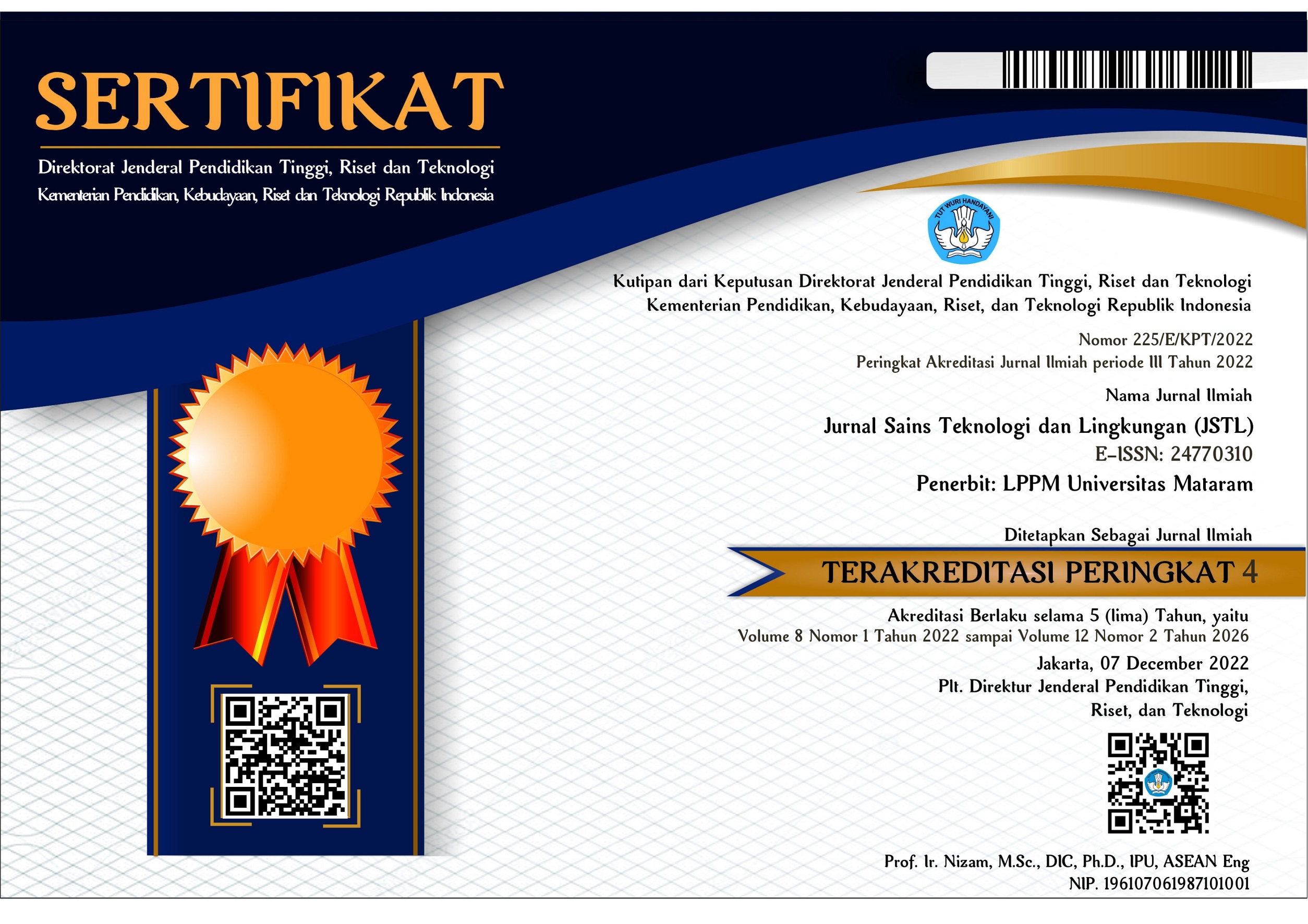Kelimpahan dan Biomassa Ikan Karang di Kawasan Konservasi Perairan Gili Balu, Kabupaten Sumbawa, Nusa Tenggara Barat
DOI:
https://doi.org/10.29303/jstl.v10i2.656Abstract
The Gili Balu Marine Conservation Area (KKP), located in Sumbawa Regency, West Nusa Tenggara, is ecologically and economically significant due to its rich coral reef ecosystems. This research aims to measure the abundance and biomass of reef fish in the KKP Gili Balu, which can be used as a basis for evaluating the effectiveness of conservation efforts in maintaining marine biodiversity. The Underwater Visual Census (UVC) method was used, recording types of reef fish at ten observation points. The results showed that the highest abundance was found on Mandiki Island, with functional fish abundance reaching 2973 ind/ha, followed by Pasareang Barat Island (1903 ind/ha) and South Kalong (1600 ind/ha). The biomass of functional fish also reflects their important role in maintaining the balance of the coral reef ecosystem. This research contributes to the scientific understanding of marine biodiversity in the KKP Gili Balu and provides a basis for sustainable conservation management efforts. Additionally, the research recorded the presence of several coralivorous and economically important fish species, although they tend to be smaller compared to functional fish. Economically important fish in the KKP Gili Balu waters were found only at four observation locations: East Belang Island, North Belang, Kenawa, and Southwest Namo. The highest value was recorded at Kenawa Island, with 93 ind/ha. These fish tend to be rare in this area, possibly due to past fishing practices.References
Alhadad, I., Mustar, N. M., & Fadhilah, N. (2022). Assessment of Coral Reef Fish Biodiversity in Marine Protected Areas. Journal of Marine Biology Research.
Pardede, S. T., Arifin, Z., & Subhan, B. (2013). Effect of Marine Protected Areas on Reef Fish in Indonesia. Indonesian Fisheries Journal, 8(2), 102-115.
Heryati, N. (2019). Peran Ekologis Ikan Karang dalam Ekosistem Laut. Marine Science Review, 12(1), 45-60.
Belinda, T., Rahman, A., & Saputra, A. (2022). Dinamika Populasi Ikan Karang di Asia Tenggara. Asian Marine Biology, 10(3), 203-218.
Tambunan, H., Wiryawan, B., & Purnomo, A. (2020). Strategi Konservasi untuk Ekosistem Terumbu Karang. Environmental Management Journal, 15(4), 275-290.
Sahetapy, Y., Nursyamsi, D., & Gunawan, T. Keanekaragaman dan Distribusi Ikan Karang di Wilayah Pasifik. Pacific Marine Science, 19(2), 150-167.
Suryatini, D., & Rai, M. Pemantauan Ekologis Terumbu Karang di Indonesia. Indonesian Journal of Marine Studies, 6(3), 89-104.
Medina, R., Kusuma, H., & Anwar, F. (2021). Assemblages of Coral Reef Fish: Structure and Function. Ecological Indicators, 45, 315-330.
Khoiri, N., Putri, W. S., & Utomo, H. (2022). Dampak Perubahan Iklim terhadap Ikan Terumbu Karang. Journal of Marine and Coastal Sciences, 18(1), 67-82.
Allen, G. R., & Erdmann, M. V. (2012). Reef Fishes of the East Indies. Perth, Australia: Tropical Reef Research.
English, S., Wilkinson, C., & Baker, V. (1997). Survey Manual for Tropical Marine Resources. Townsville: Australian Institute of Marine Science.
Odum, E. P. (1971). Fundamentals of Ecology. Philadelphia: W.B. Saunders.
Hastuty, S., Yulianto, I., & Prayogo, D. (2014). Keanekaragaman dan Kelimpahan Spesies Ikan Terumbu Karang di Indonesia. Journal of Fish Biology, 25(4), 327-340.
Kulbicki, M., Bozec, Y., & Labrosse, P. (2005). Patterns of Fish Biodiversity in Coral Reefs. Coral Reefs, 24(1), 85-99.
Sudirman, S., & Setiawan, F. (2021). Metode Survey Ikan Karang: Teknik Pengelompokan Berdasarkan Fungsi Ekologis dan Nilai Ekonomis. BRIN Publication Series. Jakarta: Badan Riset dan Inovasi Nasional.
BRIN. (2021). Pedoman Pengelompokan dan Monitoring Ikan Karang di Kawasan Konservasi Perairan. Jakarta: Badan Riset dan Inovasi Nasional.
Smith, J. E., Hunter, C. L., & Conklin, E. J. (2010). Coral Reef Fish Responses to Marine Protected Areas. Marine Ecology Progress Series, 399, 93-107.
Jones, G. P., Srinivasan, M., & Almany, G. R. (2015). Larval Dispersal and Marine Reserve Design. Conservation Biology, 29(1), 105-116.
Williams, I. D., & Polunin, N. V. C. (2001). Large-Scale Associations between Macroalgal Cover and Grazer Biomass on Mid-Depth Reefs in the Caribbean. Coral Reefs, 19(4), 358-366.
Downloads
Published
Issue
Section
License

This work is licensed under a Creative Commons Attribution-NonCommercial-ShareAlike 4.0 International License.


1.png)











